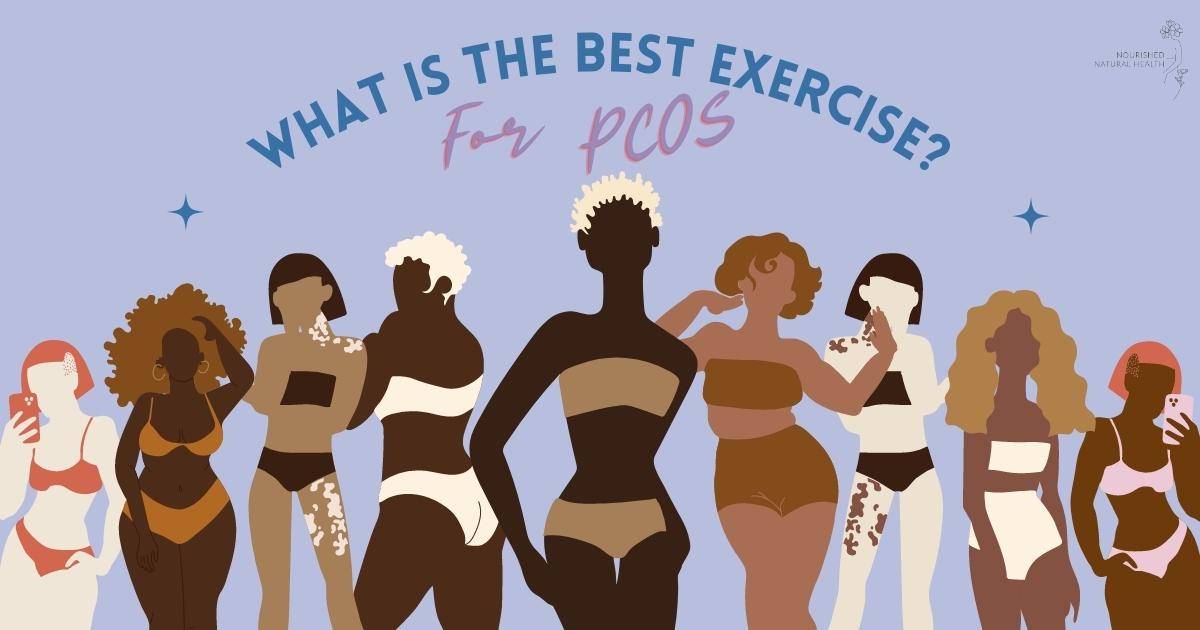
Movement and Exercise for PCOS
When it comes to movement and PCOS, finding the right balance is key.
Both too much and too little exercise can worsen PCOS symptoms.
In this chapter, we’ll cover how to work out if you are over or under exercising as well as the best form of exercise for PCOS.
Are you overdoing exercise?
An interesting study found that moderately-high to high intensity exercise (such as a spin or HIIT class) increased cortisol levels, whereas low intensity exercise lowered cortisol.119
Higher cortisol levels trigger your adrenal glands to release excess DHEAS which in turn increase the symptoms of PCOS like acne, hair changes, and irregular cycles.
What's more, the study found that this increased cortisol production persisted for several hours after completing the workout.
For the 80% of Cysters with Insulin-Resistant PCOS, this is an issue because high cortisol levels trigger your body to release glucose into your bloodstream.
If, like many of us, you spend the majority of your day sitting at a desk, this extra glucose isn't used by your muscles.
Having too much glucose sitting in your blood is dangerous, so your body increases its production of insulin to bring the levels down.
Over time, this can worsen insulin resistance as well as increase inflammation.
So how do you know if you are overdoing exercise?
Look at how quickly you recover after finishing a workout or session.
You should recover and feel more energized within 30 minutes.
If you feel more fatigued, this is a sign that you overdid it.
When one of my clients, Sammi, first came to see me she proudly announced that she worked out so intensely that she would collapse on the couch or need to take a nap afterward.
Exercising to fatigue is not a sign of a "good" workout and is not sustainable.
The other telltale sign is changes to your sleep.
If you notice you take longer than 20 minutes to fall asleep at night, wake frequently through-out the night, or wake up feeling unrefreshed even after enough hours in bed, this is a sign that your stress hormones may be out of whack.
Try reducing the intensity of your exercise for a few days whilst keeping your other habits similar to observe if your workouts might be impacting your sleep.
Are you getting enough exercise?
Getting some form of movement into your week is important for improving insulin resistance, lowering inflammation, and keeping stress hormones at bay.
The International Evidence Based Guidelines for PCOS recommend “a minimum of 150 min/week of moderate intensity physical activity or 75 min/week of vigorous intensities or an equivalent combination of both, including muscle strengthening activities on 2 non-consecutive days/week”.120
This could be a 15-minute walk to and from your car or the train station each work day, plus some simple squats and lunges twice a week at home.
If exercise is new for you, start small and build from there.
The “best” exercise for PCOS
Despite what you might have heard from influencers, there is no one “perfect” exercise for PCOS.
The best exercise plan for you is the one you actually enjoy and will keep on doing.
Remember that to control your PCOS symptoms, you will need to follow the PCOS Repair principles for the rest of your life, not just a few weeks.
We are creating sustainable habits that you can stick with, instead of just another fad you can’t sustain.
Taking the time to experiment with different forms of movement is important in determining what works for you.
If you are open to different types of exercise and would like to maximize your results, I have found my clients have great results with a combination of HIIT or strength-based exercises plus low intensity movement.
This might look like two or three 20-minute HIIT/body-weight sessions per week, plus a 30-minute walk or cycle most days.
It might be more or less than this based on your root cause, your current fitness level, and your schedule.
For Adrenal PCOS with very high stress levels, you might like to skip HIIT sessions for now, or keep them to under ten minutes while your stress hormones recover.
HIIT exercise involves short bursts of high intensity exercise, lasting around one to four minutes, followed by a short period of recovery.121
A total HIIT workout, including a warmup and cooldown usually lasts around 20-25 minutes and can be completed from home, a park, or even a spare meeting room in the office.
Many of my busy clients find that squeezing in a short HIIT session at a time that works for them is much more doable than trying to make a class at the gym or committing to a long walk or run.
It can be a great way to give you a quick burst of energy to break up your day.
You can follow a guided workout video or create a simple series of exercises using your own bodyweight.
It doesn’t have to be complicated or fancy.
For example, you could complete one minute each of squats, pushups on your knees, jogging on the spot, and a plank hold with a 30-second rest in between each exercise, and repeated twice.
With a minute of warming up and cooling down on either side, this whole sequence would take just 14 minutes but would increase your heart rate, boost your metabolism, and get lots of different muscle groups firing.
Contrary to popular belief, short HIIT-style workouts have been shown to be as effective at improving cardiovascular health and aerobic capacity as endurance-based cardio exercise (such as jogging or cycling).119
This style of movement also has the added benefit of increasing your muscle’s sensitivity to insulin, so is arguably more beneficial for women with PCOS.
That said, if you know that you don’t enjoy HIIT workouts and love a longer jog, swim, or bike ride, then stick with it!
The best form of exercise for your PCOS is the one that you will stick with in the long run.
"So long as you feel energized afterward and aren’t noticing negative impacts on your sleep, keep up any form of movement that makes you feel good."
Bonus points if you can tie your exercise to something you look forward to such as a catchup walk with a friend or dancing to your favorite music.
Incidental movement for the win
Some of the best forms of exercise to lower cortisol and inflammation and improve insulin resistance are low-intensity exercises like walking, gentle swimming, gardening, and playing with your kids.
Aim to include as much of this in your day as possible. If you work at a desk, consider trialing a standing desk.
Organize walking meetings or catch ups with friends. Park further away.
Or take a walk around the block on your lunch break.
Let go of exercising to lose weight
For most of my life, I equated exercise with losing or maintaining my weight.
If your PCOS diagnosis was anything like the majority of Cysters I’ve met, you were probably told to “eat less and exercise more.”
You likely found that exercise wasn’t working, so you worked out harder and for longer, still with no results.
It’s no wonder working out has a negative connotation for so many Cysters.
It’s time to let the calories in, calories out equation go.
This doesn’t apply for PCOS.
When your root cause is ruling your body, it is almost impossible to lose weight, even when you are in a calorie deficit.
By working on lowering your insulin, cortisol, and inflammation, you’ll be able to move your body out of a place of danger and into one of safety.
Once your body systems are working in harmony again, you will find weight loss is far more achievable.
For a deep dive into weight loss in PCOS, I’ve put together a bonus resource for you: Simple Weight Loss Strategies for PCOS.
Can’t start exercising? Try these three tricks
Sometimes getting into a routine with regular exercise can be really hard, even when you know it is helpful for your PCOS.
Try these three simple tricks that have helped many of my clients:
Pack your bag the night before
It sounds trivial, but getting organized before going to bed at night can really help with motivation the next morning.
If you are going to a gym class, pack your bag so you can grab it and go before letting the excuses creep in.
If you exercise at home, lay your shoes and socks out next to your mat, fill a water bottle and decide on the routine you’ll follow so you can simply hit play and get started.
The five-minute rule
The five-minute rule is a technique used in cognitive behavioral therapy to help with procrastination.
You can use this in any area of your life where you struggle to get started, but it works particularly well with exercise.
If you just can’t start your workout because the idea of a full 20 minutes seems overwhelming, tell yourself you only have to commit to five.
Do just the first five minutes of a workout and then stop and assess.
Do you think you could do another five?
99% of the time, you’ll find that once you get going and the endorphins start flowing, you’ll be able to keep going.
If after the first five minutes you genuinely feel too tired to keep going – honor that.
Your body knows what’s best.
Exercise snacking
This technique works well if you genuinely don’t have time to exercise because of your schedule.
Instead of a formal exercise practice, try adding “snack sized” bursts of exercise throughout your day.
For example, while you are waiting for the kettle to boil, do ten squats.
While in the lift, do five calf raises (rise up from flat feet onto your toes and back down again).
When you’re on the phone, march on the spotor walk around the meeting room.
References used for this article
circulating cortisol levels: the intensity threshold effect. J Endocrinol Invest.
2008;31(7):587-591.
Monash University. International evidence-based guideline for the assessment
and management of polycystic ovary syndrome 2018. Jean Hailes. https://assets.jeanhailes.org.au/Tools/PCOS_evidence-based_guideline_for_assess-
ment_and_management_pcos.pdf
Gaesser GA, Angadi SS. High-intensity interval training for health and fitness:
can less be more? J Appl Physiol. 2011;111(6):1540-1541.









No Comments Yet
Be the first to share your thoughts!
Leave a Comment